ELEPHANTA CAVES
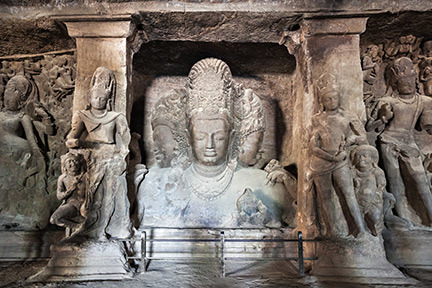
These caves located on an Island 9kms away off the commercial capital of India, Mumbai, are the gems of rock cut cave temples. This UNESCO World Heritage site can be reached by a 45 minutes ferry ride from the Gateway of India.
One can see both Hindu & Buddhist caves here. One of the structures amongst these caves which stand out the most is a 20 ft high three headed Lord Shiva monolith idol which is hewn from solid basalt rock.
BADAMI CAVES

One of the best rock cut architectures of India, this structure was carved out of soft sandstone monolith on a cliff.
The amazing carving in this group of 4 caves from 6th Century, belonging to Hindu & Jaina sect, will leave everyone spellbound. Badami is an integral part of tourist circuit in Karnataka along with mystic place Hampi, where it looks like time stood still.
THE BAGH CAVES
Carved in 5 – 6th century CE, these 9 rock cut caves are another great example of rock cut architecture in India. They are located in Dhar, close to the city of Indore in Madhya Pradesh. The paintings at these caves, now preserved in a museum, are the most fascinating. They are as good as the paintings of Ajanta.
Take a peep at the caves in this short video.
MASRUR ROCK CUT TEMPLES
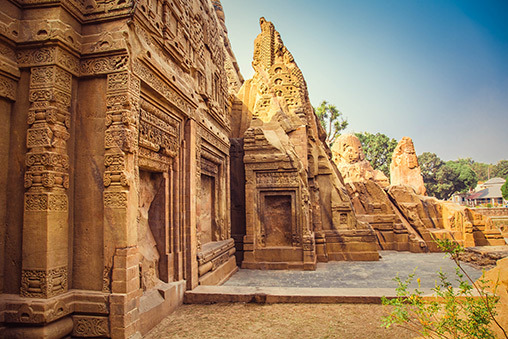
Known as the Himalayan pyramids, these rock cut temples are a testimony of the perfection achieved by the artisans. Believed to have been built in 8th – 9th century CE, this complex has 15 rock cut temples carved out from a single rock with 1 temple at the center & 14 surrounding this central temple.
These amazing temples are comparatively lesser known but one will be surprised by the details with which the carvings have been done. The lake near the temple adds to the beauty of the complex.
This is a must visit while visiting Dharamsala (approx. 40 Kms), the place where Dalai Lama lives.
FIVE RATHAS
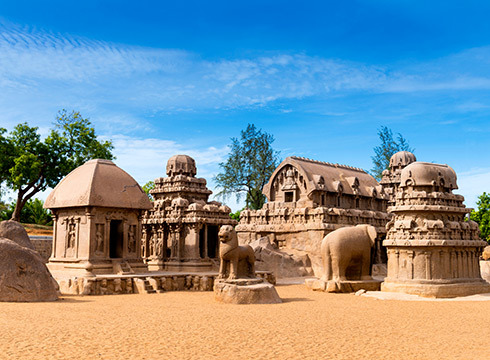
This phenomenal rock cut temple complex having 5 intricately carved monolithic temples is located in Mahabalipuram, near Chennai.
Each of the monuments in this complex resembles a ‘Chariot’ and were cut out from solid granite & diorite rocks. A part of the UNESCO World Heritage site, the architectural elegance & the wonderful carvings puts these temples in the list of must visit monuments in India.
Representing a spectacular specimen of the skills of ancient Indian artists, rock cut architecture occupies a very important place in the history of India. Mostly adorned with exquisite stone carvings and paintings, these unforgettable impressions of brilliant artwork will surely be etched into the memory of the visitors forever. At Indo Asia Tours, all the trips are curated mindfully to explore the charisma of bold, vibrant, and detailed spectacle of various artworks.

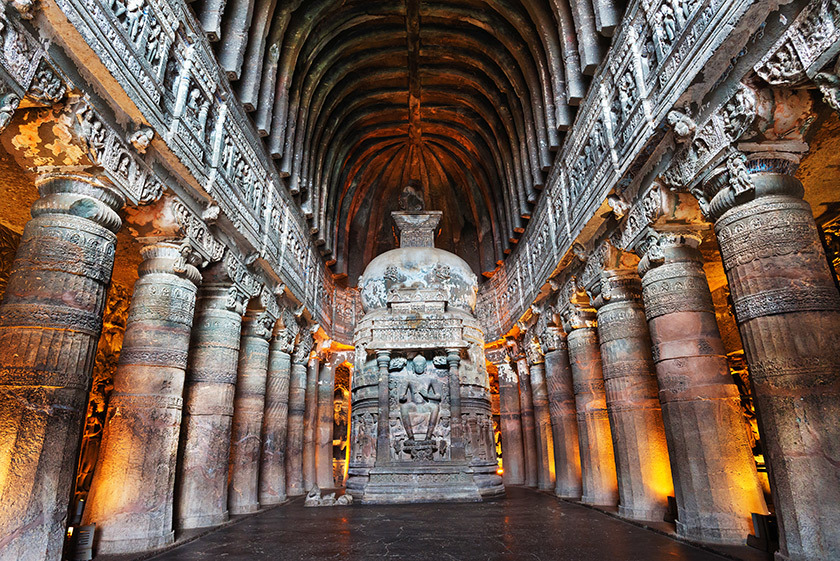 Historically, there are evidences of natural caves being used by humans as early as 8000 BC. The trend continued in India & during the time of Buddha the caves started to be used by the monks for meditation & also for residential purposes. This perfectly blended with their religious idea of asceticism & monastic life. Since Buddhism spread through the trade routes, and quite a lot of the cave temples were located along trade routes, they started to act as stopovers for traders. These caves then started being decorated intricately. The artisans kept on improvising but they never forgot the basics of carving on wood. So they imitated the carvings & structure of wooden architecture on rocks as well & ended up carving beautiful pillars, arches & facades in the form of these caves. When Buddhism declined & Hinduism started flourishing again around 8th century AD, the responsibility of further improvising the rock cut architecture was taken over by the Hindu Kings, especially in South India, when it reached its zenith.
Historically, there are evidences of natural caves being used by humans as early as 8000 BC. The trend continued in India & during the time of Buddha the caves started to be used by the monks for meditation & also for residential purposes. This perfectly blended with their religious idea of asceticism & monastic life. Since Buddhism spread through the trade routes, and quite a lot of the cave temples were located along trade routes, they started to act as stopovers for traders. These caves then started being decorated intricately. The artisans kept on improvising but they never forgot the basics of carving on wood. So they imitated the carvings & structure of wooden architecture on rocks as well & ended up carving beautiful pillars, arches & facades in the form of these caves. When Buddhism declined & Hinduism started flourishing again around 8th century AD, the responsibility of further improvising the rock cut architecture was taken over by the Hindu Kings, especially in South India, when it reached its zenith.  Dating back to prehistoric times, these caves in the state of Madhya Pradesh are an evidence of earliest human life in India. This UNESCO world heritage site has 7 hills & about 750 cave shelters.
Dating back to prehistoric times, these caves in the state of Madhya Pradesh are an evidence of earliest human life in India. This UNESCO world heritage site has 7 hills & about 750 cave shelters.
 Bhaja caves in Maharashtra are a group of 25 caves belonging to Hinayana sect of Buddhism & date back to 2nd century BCE. They were strategically located on trade route from Arabian Sea to Deccan plateau which is about 56 km from today’s Pune.
Bhaja caves in Maharashtra are a group of 25 caves belonging to Hinayana sect of Buddhism & date back to 2nd century BCE. They were strategically located on trade route from Arabian Sea to Deccan plateau which is about 56 km from today’s Pune.
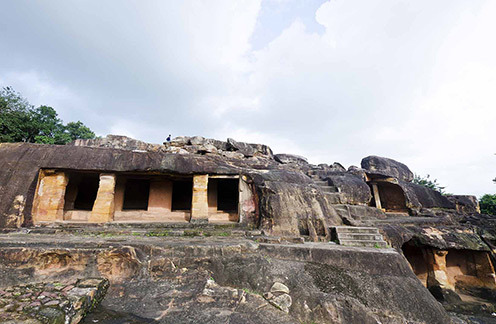 Located on the adjacent hills, in the suburbs of Bhubaneshwar, Odisha, the caves of Udaygiri & Khandagiri are a must visit to appreciate the cave temples architecture. Carved out in 1st century BCE, these caves mainly served as residences for the Jain monks.
Located on the adjacent hills, in the suburbs of Bhubaneshwar, Odisha, the caves of Udaygiri & Khandagiri are a must visit to appreciate the cave temples architecture. Carved out in 1st century BCE, these caves mainly served as residences for the Jain monks.
 Dating from 2nd century BC to 480 CE, Ajanta caves are a UNESCO World Heritage site & is amongst the oldest & the best rock cut structures in India.
Dating from 2nd century BC to 480 CE, Ajanta caves are a UNESCO World Heritage site & is amongst the oldest & the best rock cut structures in India.
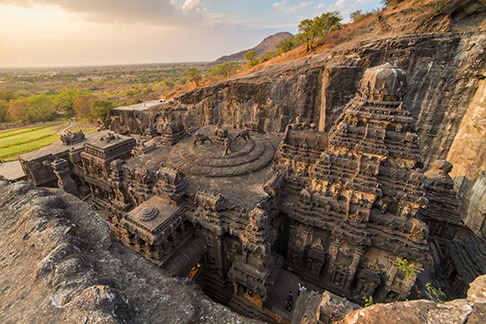 Considered as epitome of Indian rock cut architecture, these 34 caves are located about 30 km from Aurangabad. Here one will find caves belonging to Buddhist, Hindu as well as Jain faith. This is a testimony of the religious tolerance that has been part of the Indian society since time immemorial.
Considered as epitome of Indian rock cut architecture, these 34 caves are located about 30 km from Aurangabad. Here one will find caves belonging to Buddhist, Hindu as well as Jain faith. This is a testimony of the religious tolerance that has been part of the Indian society since time immemorial.
 These caves located on an Island 9kms away off the commercial capital of India, Mumbai, are the gems of rock cut cave temples. This UNESCO World Heritage site can be reached by a 45 minutes ferry ride from the Gateway of India.
These caves located on an Island 9kms away off the commercial capital of India, Mumbai, are the gems of rock cut cave temples. This UNESCO World Heritage site can be reached by a 45 minutes ferry ride from the Gateway of India.
 One of the best rock cut architectures of India, this structure was carved out of soft sandstone monolith on a cliff.
One of the best rock cut architectures of India, this structure was carved out of soft sandstone monolith on a cliff.
 Known as the Himalayan pyramids, these rock cut temples are a testimony of the perfection achieved by the artisans. Believed to have been built in 8th – 9th century CE, this complex has 15 rock cut temples carved out from a single rock with 1 temple at the center & 14 surrounding this central temple.
Known as the Himalayan pyramids, these rock cut temples are a testimony of the perfection achieved by the artisans. Believed to have been built in 8th – 9th century CE, this complex has 15 rock cut temples carved out from a single rock with 1 temple at the center & 14 surrounding this central temple.
 This phenomenal rock cut temple complex having 5 intricately carved monolithic temples is located in Mahabalipuram, near Chennai.
This phenomenal rock cut temple complex having 5 intricately carved monolithic temples is located in Mahabalipuram, near Chennai.
 Thank you, patrons, for reposing faith in our destinations and enquiring for customised virtual destination awareness training programs. We are proud to conduct them successfully so far and are looking forward to hold similar virtual destination awareness training programs for your team or yourself or a virtual tour for your clients. Let us know the destination of your interest along with your convenient date / time and we will be happy to set up a program for you.
Thank you, patrons, for reposing faith in our destinations and enquiring for customised virtual destination awareness training programs. We are proud to conduct them successfully so far and are looking forward to hold similar virtual destination awareness training programs for your team or yourself or a virtual tour for your clients. Let us know the destination of your interest along with your convenient date / time and we will be happy to set up a program for you.

